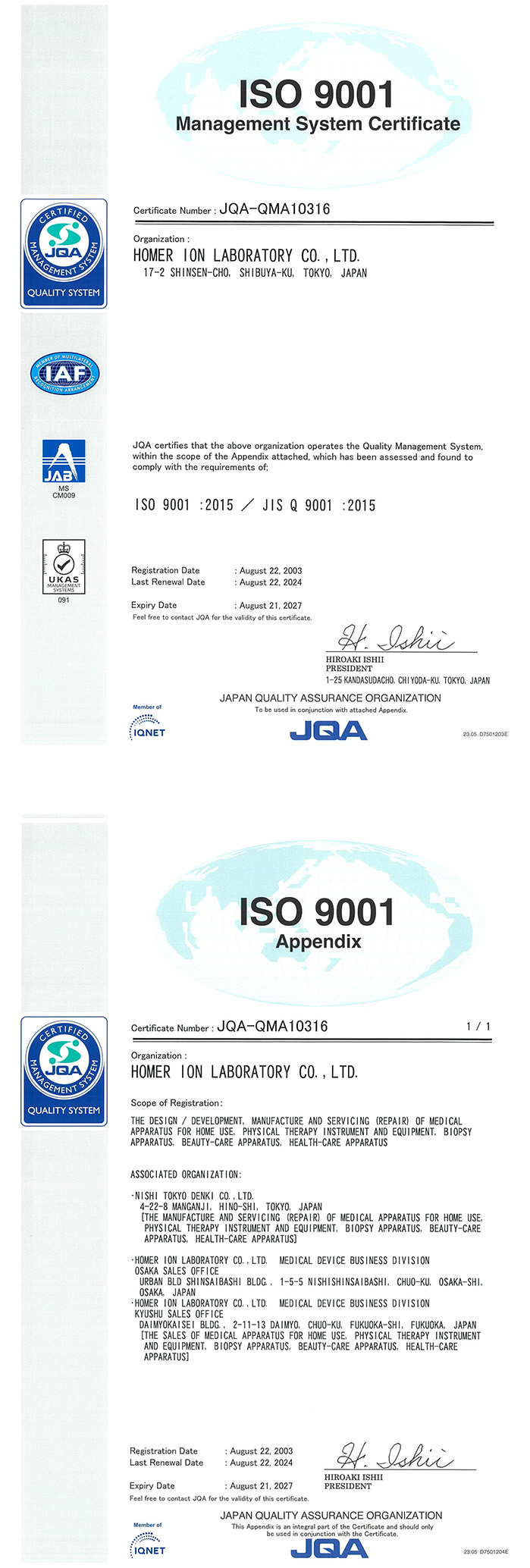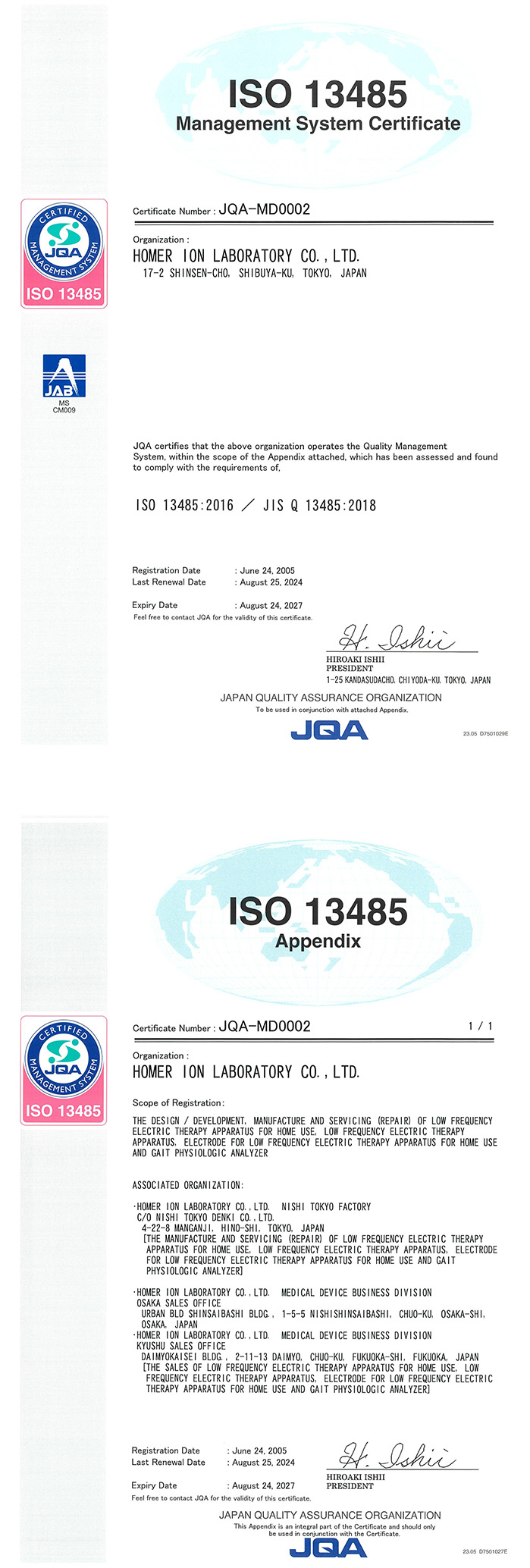

Interview November 2017 [Archived Distribution]
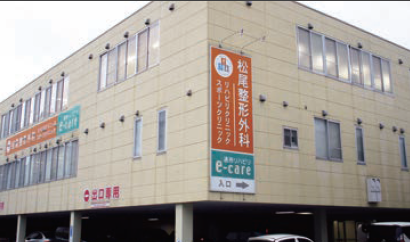
Located in Miyoshi City, Hiroshima Prefecture, this clinic places strong emphasis on exercise-phase rehabilitation, providing treatment for postoperative rehabilitation, sports injuries, osteoarthritis, spinal disorders, and musculoskeletal instability. At the same time, under the theme of “Commitment to Results,” the clinic also conducts day rehabilitation (day care). Careful assessment of both physical and mental functions as well as activities of daily living is carried out, with the aim of improving these functions for many users. The program works to enhance ADL (Activities of Daily Living) and IADL (Instrumental Activities of Daily Living), while supporting role creation and promoting participation in society.
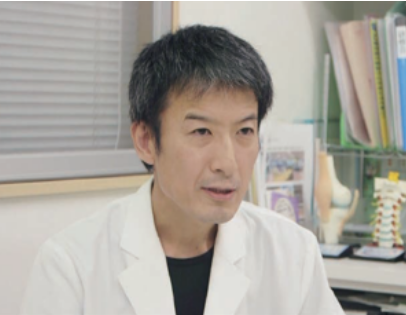
Director: Dr. Yoichiro Matsuo
Career Background
1998: Graduated from Showa University School of Medicine
Entered the Department of Orthopedic Surgery,
Hiroshima University Faculty of Medicine
Worked at Hiroshima City Hospital, Department of Orthopedic Surgery
2000: Worked at Yawatahama General Hospital, Department of Orthopedic Surgery
2002: Worked at Asa City Hospital, Department of Orthopedic Surgery
2005: Worked at Akiota Kake Hospital, Department of Orthopedic Surgery
2007: Worked at Saiseikai Kure Hospital, Department of Orthopedic Surgery
2008: Worked at Takanobashi Central Hospital, Department of Orthopedic Surgery
2010: Established Matsuo Orthopedic & Rehabilitation Clinic
Qualifications and Certifications
Board Certified Specialist, Japanese Orthopaedic Association
Certified Sports Doctor, Japan Sports Association
Certified Sports Doctor, Japanese Orthopaedic Association
Certified Health and Sports Physician, Japan Medical Association
Dr. Matsuo’s Approach to Rehabilitation in Orthopedics and Long-Term Care
In orthopedics, most patients come with complaints of pain. First, we aim to reduce pain through instructions for local rest or immobilization, medication, physical therapy, or injections. After the acute phase, we introduce rehabilitation. I believe rehabilitation is a highly effective means to alleviate symptoms and restore the body’s original condition as early as possible. In long-term care, rehabilitation differs from medical rehabilitation. Here, the focus is on recovery and maintenance phases. For individuals with cerebrovascular, cardiopulmonary, or orthopedic conditions, as well as those with neurodegenerative diseases or disuse syndrome, who are unable to stand, walk, or perform activities of daily living without assistance—or who can do so independently but only with difficulty—rehabilitation is provided. My goal is to support functional recovery and, even gradually, to help individuals find new roles and opportunities for social participation.
Even those who cannot perform conventional strength training can still engage in muscle training
-Background of B-SES Introduction
Dr.Matsuo: For individuals unable to move sufficiently due to pain or unable to engage in high-load exercise, and for those with paralysis or spasticity from cerebrovascular or neurological diseases who cannot perform conventional resistance training using machines, I had been considering how best to provide them with training opportunities.
-Target Conditions for B-SES in Day Rehabilitation
Dr.Matsuo: B-SES can be used for all individuals who require strengthening of the lower limb muscles, except for those with pacemakers. In particular, many patients in day rehabilitation suffer from impaired mobility due to conditions such as stroke or Parkinson’s disease and cannot voluntarily contract their muscles. For such cases, B-SES can increase muscle mass by adjusting output. I also believe it may be effective for patients with dementia, who may have difficulty following verbal instructions.
-Clinical Effects of B-SES
Subjects: A total of 27 patients (9 male, 18 female)
Target conditions: Osteoarthritis of the knee, osteoarthritis of the hip, post-total joint replacement (hip and knee), and post-anterior cruciate ligament (ACL) reconstruction.
Method: B-SES was applied twice per week (with at least one rest day in between). Body composition was measured every month using InBody (a high-precision body composition analyzer), and changes were observed over six months.
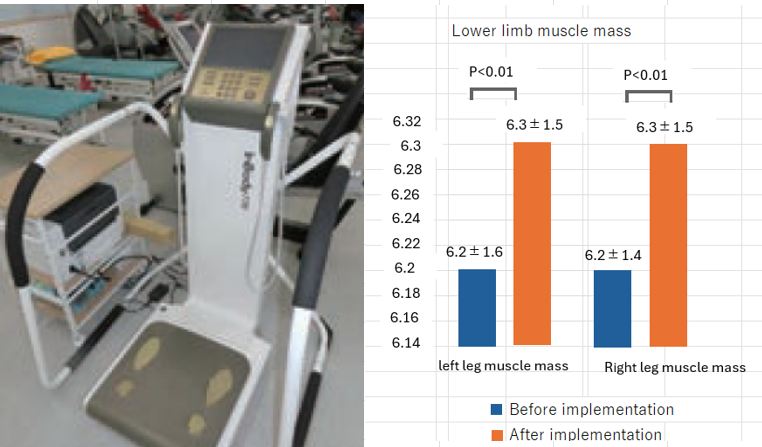
※ 2017 – 4th Annual Meeting of the Japan Skeletal Muscle Electrical Stimulation Society – Presentation by our clinic’s physical therapist, Mr. Fukuda
Dr.Matsuo: According to the results of our clinic’s study, although we were unable to make direct comparisons with a control group, data showed a statistically significant increase in lower limb muscle mass on both sides after B-SES treatment. Furthermore, many patients reported improvements such as pain relief and increased ease of movement.
High Continuation Rate of Twice-Weekly Outpatient Visits
-Continuation of Rehabilitation and Word-of-Mouth with B-SES
Dr.Matsuo: In the orthopedic department, we have administered B-SES to 122 patients. Excluding those with clear reasons for discontinuation, such as surgery or hospitalization, the continuation rate was as high as 92%. In addition, some patients even recommend B-SES to others.
-Advantages of Introducing B-SES in Clinics
Dr.Matsuo: The benefits include expected increases in lower limb muscle mass and muscle strength. Also, since B-SES is scheduled twice a week with at least one day of rest in between, and appointments are reservation-based, I believe this system has encouraged patients to continue attending regularly.
-Medical and Long-Term Care Reimbursement for B-SES
Dr.Matsuo: In orthopedics, B-SES is reimbursed as an anti-inflammatory and analgesic procedure at 35 points. In the long-term care setting, it is included as part of the bundled reimbursement system.
Contribution to an Aging Society through Orthopedics and Long-Term Care
–Four Types of Muscle Training
Dr.Matsuo: By 2025, one in five citizens will be a late-stage elderly person aged 75 or older. The Ministry of Health, Labour and Welfare has emphasized the importance of initiatives to prevent not only the progression of lifestyle-related diseases but also frailty in the elderly (including malnutrition, reduced physical and cognitive function, etc.). Likewise, the Japanese Orthopaedic Association proposed the concept of locomotive syndrome in 2007 to promote the extension of healthy life expectancy. Preventing sarcopenia (the loss of muscle mass due to aging or illness) by increasing muscle mass and strengthening muscles is crucial. At our clinic, we provide four types of muscle training, selecting the most appropriate method for each individual.
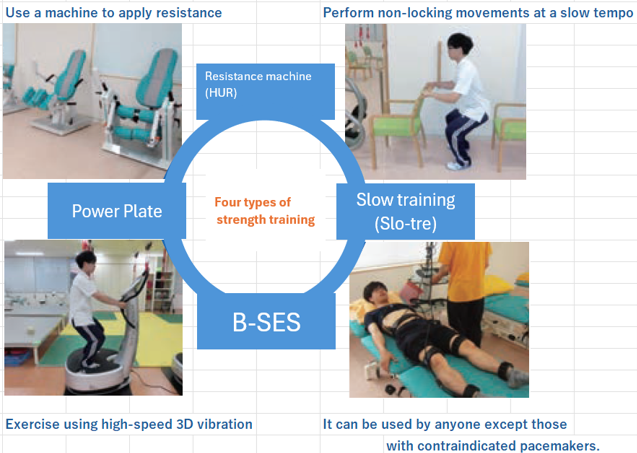
※ Slow Training (Slo-Training) is a muscle strength training method developed by Professor Naokata Ishii of the Graduate School of the University of Tokyo.
Among these methods, B-SES utilizes cylindrical belt electrodes applied to both lower limbs, which increases the electrode’s contact surface area. As a result, it can induce strong muscle contractions in both the flexor and extensor muscle groups. Compared with conventional EMS, B-SES is expected to provide significantly greater benefits in terms of increasing lower limb muscle mass and enhancing muscle strength. Furthermore, when combined with interventions by registered dietitians for improvements in malnutrition, its effectiveness may be further enhanced.
-Future Prospects of B-SES
Dr.Matsuo: B-SES is a highly suitable device for preventing frailty in the elderly, as it allows even those with multiple complications, particularly those unable to move independently, to engage in muscle training. If this device becomes more widely adopted in hospitals, clinics, and care facilities nationwide, it may lead not only to increased lower limb muscle mass and strength, thereby improving ADL and IADL, but also contribute to weight management and the improvement of lifestyle-related diseases. Ultimately, I believe it will play an important role in extending the healthy life expectancy of the Japanese population.
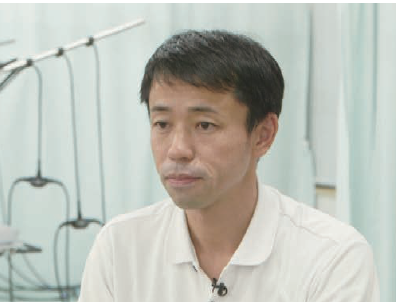
Physical Therapist: Takafumi Fukuda
Career Background
2000: Graduated from Yamaguchi Co-Medical College
2000: Worked at Takanobashi Central Hospital
2010: Worked at Matsuo Orthopedic & Rehabilitation Clinic
Qualification: Licensed Physical Therapist
Physical Therapist Fukuda’s Approach to Rehabilitation in Orthopedic Practice
In both medical care and long-term care, I strive to provide effective rehabilitation based on medical evidence under the instruction of physicians. At the same time, I believe the ultimate goal is to improve the patient’s quality of life (QOL). In long-term care, beyond functional improvement, I hope to contribute to enhancing patients’ sense of purpose and fulfillment in life.
-Implementation Method and Therapeutic Effects of B-SES
Physical Therapist Fukuda: At our clinic, B-SES is conducted in the disuse mode for 15 minutes per session, performed in the supine position, twice a week. To allow for muscle recovery, we always ensure that at least one full day separates each session. For patients who have undergone ACL or PCL reconstruction, since risks are involved, we also use weights while ensuring that no undue stress is placed on the ligaments. According to InBody results, increases in muscle mass have been observed, and subjectively, I feel that improvements in basic motor functions are also becoming evident.
Day Rehabilitation Program: Same as Orthopedics, but for Patients with Lower Mobility
Physical Therapist Fukuda: At our clinic, the program centers on muscle training and aerobic exercise. In terms of muscle training, we adopt various approaches, with B-SES being particularly used for patients whose basic motor functions have declined.
Differences Between Rehabilitation in Orthopedics and Long-Term Care
Physical Therapist Fukuda: In day rehabilitation, the mode and muscle stimulation settings are the same as in orthopedics, but B-SES is more often applied to patients with significantly reduced mobility.
Daily Life Became Easier, Motivation Increased
-Patient Feedback
Physical Therapist Fukuda: In orthopedics, many patients seek pain relief, and we frequently hear feedback such as “the pain has eased” or “walking has become easier.” In long-term care, patients often say things like, “I can now stand and do housework, which I couldn’t do before,” or “Recently, I can move a little without pain.” These voices reflect improvements that make daily living easier.
-Benefits of Introducing B-SES
Physical Therapist Fukuda: Some patients are initially reluctant toward rehabilitation, but once they experience the effects of B-SES and feel some improvement, their motivation to engage in rehabilitation increases. I have seen this happen in practice.
-Future Prospects of B-SES
Physical Therapist Fukuda: As a physical therapist, at present I have only used B-SES in the supine position. However, I am interested in trying it in seated positions or on tilt tables to see what kinds of effects it may have. If the opportunity arises, I would like to explore this further.
